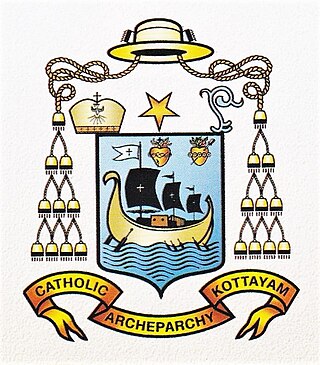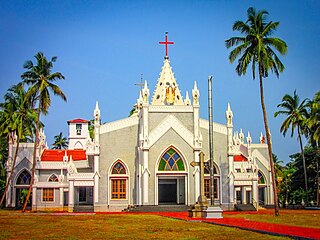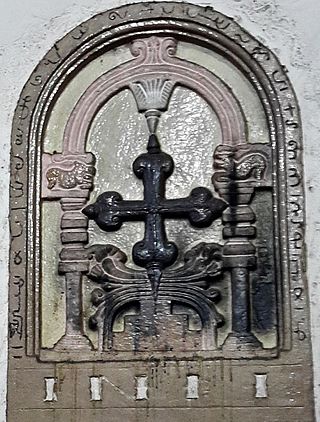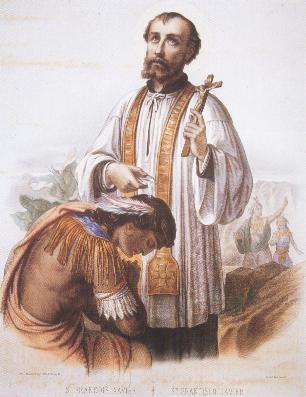
The Syro-Malabar Church, also known as the Syro-Malabar Catholic Church, is an Eastern Catholic Church based in Kerala, India. It is a sui iuris (autonomous) particular church in full communion with the Holy See and the worldwide Catholic Church, with self-governance under the Code of Canons of the Eastern Churches (CCEO). The major archbishop presides over the entire church. The incumbent Major Archbishop is Raphael Thattil, serving since January 2024. The Syro-Malabar Synod of Bishops canonically convoked and presided over by the major archbishop constitutes the supreme authority of the church. The Major Archiepiscopal Curia of the church is based in Kakkanad, Kochi. Syro-Malabar is a prefix reflecting the church's use of the East Syriac Rite liturgy and origins in Malabar. The name has been in usage in official Vatican documents since the nineteenth century.

The Catholic Church in Thailand is part of the worldwide Catholic Church, under the spiritual leadership of the Pope in Rome.

Saint Francis Church, in Fort Kochi, Kochi, originally built in 1503, is one of the oldest European churches in India and has historical significance as a witness to the European colonial ambitions in the subcontinent. The Portuguese explorer Vasco da Gama died in Kochi in 1524 when he was on his third visit to India. His body was originally buried in this church, but after fourteen years his remains were relocated to Lisbon and is now interred at Jerónimos Monastery.

The Diocese of Quilon is a Latin Church ecclesiastical jurisdiction or diocese of the Catholic Church based in the southern Indian city of Kollam. It is a suffragan in the ecclesiastical province of the metropolitan Archdiocese of Trivandrum. The Diocese of Quilon covers an area of 1,950 km2 that contains a population of some 4.8 million. At least 4.8% of the people in the area are Catholic.

The Catholic Church in India is part of the worldwide Catholic Church under the leadership of the Pope. There are over 20 million Catholics in India, representing around 1.55% of the total population, and the Catholic Church is the single largest Christian church in India. There are 10,701 parishes that make up 174 dioceses and eparchies, which are organised into 29 ecclesiastical provinces. Of these, 132 dioceses are of the Latin Church, 31 of the Syro-Malabar Catholic Church and 11 of the Syro-Malankara Catholic Church. Despite the very small population that Indian Catholics make up percentage wise, India still has the second-largest Christian population in Asia after the Catholic Church in the Philippines.

The Diocese of Jaffna is a Latin Church ecclesiastical territory or diocese of the Catholic Church in northern Sri Lanka. Latin Catholicism in the diocese's territory dates to the time of Francis Xavier. The current bishop is Justin Gnanapragasam.

The Archdiocese of Singapore is an exempt archdiocese of the Latin Church of the Catholic Church. Its territory includes all that is under the jurisdiction of the Republic of Singapore.

The Archeparchy of Kottayam is a Syro-Malabar Church metropolitan archeparchy of the Catholic Church in India. The archeparchy is exclusively for Knanaya faithful who claim to be the descendants of Syriac Judeo-Christians who migrated from South Mesopotamia to Kodungallur (Muziris) in South India in 4th century A.D.

Pope John Paul II created the Diocese of Kannur in the Ecclesiastical Province of Verapoly in India by bifurcating the Diocese of Calicut on 9 December 1998. The diocese consists of the Latin Catholics of Malabar residing in the revenue districts of Kannur and Kasaragod.
Missionary work of the Catholic Church has often been undertaken outside the geographically defined parishes and dioceses by religious orders who have people and material resources to spare, and some of which specialized in missions. Eventually, parishes and dioceses would be organized worldwide, often after an intermediate phase as an apostolic prefecture or apostolic vicariate. Catholic mission has predominantly been carried out by the Latin Church in practice.

This is a timeline of the history of the Syro-Malabar Catholic Church in India.

The Archdiocese of Verapoly (Verapolitana) is a Latin Church ecclesiastical territory or archdiocese of the Catholic Church, composed of Latin Catholics of Malabar and headquartered at the city of Cochin, in the south Indian state of Kerala. The archdiocese has administrative control over the suffragan dioceses of Calicut, Cochin, Kannur, Kottapuram, Sultanpet and Vijayapuram. The headquarters is located in Kochi along the Malabar Coast in India. It was originally formed as the Vicariate Apostolic of Malabar in 1657 and became a metropolitan see in 1886. Verapoly is the anglicised name of Varapuzha.

The Roman Catholic Diocese of Kottar is a Latin Rite suffragan diocese in the ecclesiastical province of, Kottar, Kanyakumari District, southern India yet depends on the missionary Roman Congregation for the Evangelization of Peoples

The Roman Catholic Metropolitan Archdiocese of Goa and Daman encompasses the Goa state and the Damaon territory in the Konkan region, by the west coast of India. The ecclesiastical province of Goa and Damaon includes a suffragan diocese, the Sindhudurg Diocese that comprises the Malvani areas of. The Archbishop of Goa also holds the titles of Primate of the East and Patriarch of the East Indies, also hold the title of the Syrian Catholic Primate of the Archdiocese of Cranganore. The beginnings lie in the Padroado system of Portuguese Goa and Damaon, in the early 1900s the primatial see was transferred back to the Sacred Congregation for the Evangelisation of Peoples, as the Padroado system of the Indo-Portuguese era was being dismantled.

St. Thomas Cathedral is the Syro Malabar Catholic cathedral of the eparchy of Irinjalakuda in India. It presently exists under the nomenclature and the Canonical Status as Cathedral in the Wake of the Origin of the New Eparchy, effected by the amalgamation of the two independent and important parishes of the locality, namely, St. George’s Forane Church and St. Mary’s church, which were amicably situated side by side for about a century.

Francis Kallarackal was the Metropolitan Archbishop of the Roman Catholic Archdiocese of Verapoly in India. He was appointed by Pope Benedict XVI on 20 February 2010.

The Saint Thomas Christian denominations are Christian denominations from Kerala, India, which traditionally trace their ultimate origins to the evangelistic activity of Thomas the Apostle in the 1st century. They are also known as "Nasranis" as well. The Syriac term "Nasrani" is still used by St. Thomas Christians in Kerala. It is part of the Eastern Christianity institution.

Mar Yaqob Abuna was one of the metropolitans of the Church of Malabar of the Saint Thomas Christians. In 1503, Mar Eliya V, the Catholicos Patriarch of the Church of the East consecrated three Bishops from the Monastery of Saint Eugene: Rabban David as Mar Yaballaha, Rabban George as Mar Denha, Rabban Masud as Mar Yaqob. The Patriarch sent these three new Bishops together with Mar Thomas to the lands of the Indians, and to the islands of the seas, which are within Dabag, and to Sin and Masin- Java, China and Maha china- Great China.

The Latin Catholics of Malabar Coast, aka Latin Christians of Kerala or Malabar Latin Catholics are a multi-ethnic religious group who constitute the ecclesiastical provinces of Verapoly and Trivandrum, which follow the Roman Rite liturgical practices of the Latin Church, on the Malabar Coast, the southwestern coast of India. They are predominantly Malayali people and speak the Malayalam language, though a subgroup of Luso-Indians speaks the Cochin Portuguese Creole. They trace their origins to the evangelization of Malabar Coast by the Dominican, Franciscan, Jesuit and Carmelite missionaries, mainly French and Portuguese.


































